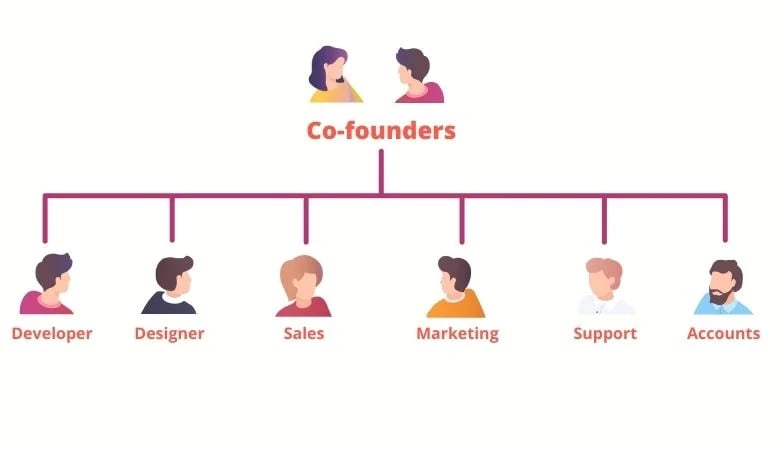Startups can be exciting successes, frustrating failures, or both at the same time. The chances of success are not great. Only 30% make it past two years, and 10% make it to five.
Building a startup org structure is crucial for navigating growth and ensuring efficient operations.
Startups often begin with a flat organizational structure, fostering agility and quick decision-making. However, as they scale, transitioning to a hierarchical structure may be necessary to maintain clarity and effectiveness. This article outlines the importance of planning for future roles and responsibilities while avoiding common pitfalls, such as assigning high-level titles prematurely. Entrepreneurs should envision their company's future, adapting their org chart to reflect evolving needs.
Utilizing tools like Functionly can streamline the creation of org charts, enhancing team accountability and resource management. Ultimately, a well-structured organization is vital to support rapid growth and achieve long-term success.
By their very nature, startups can be an intense environment with an urgency to create hyper-growth. Those that fly, fly very fast, and need systems and processes in place to handle that kind of stratospheric progress.
Many startups struggle because they fail to plan for this rapid growth stage.
They may have a great product or service and financial support to get going, but when hyper-growth hits, they find it challenging to grow the organization to handle it.
Sometimes, it’s the very entrepreneurial spirit that can create challenges. In the early stage, small groups of dedicated employees and founders work side by side in an agile development environment.
As companies grow, startups need to be more disciplined and structured — almost the exact opposite of the strategy that has led them to hyper-growth.
When developing a strategy for growth and scale, the startup's organizational structure is essential to continue to drive business.
What Is a Startup Company Org Structure?
A startup company org structure is the way the company’s reporting and hierarchy are established. It helps show who is responsible for what areas of the business, establishes a chain of command, and helps employees understand how their work fits into the company’s overall mission.
1. Flat Startup Organizational Structure
In the early stages, most startups will adopt a flat org structure. This helps create faster expansion because it’s less structured than competitors that may have complex management hierarchies.
It also fosters faster decision-making. A flat org structure has few (or no) layers of management. Employees have responsibilities but may work as a team rather than report to a manager. In other cases, everyone reports to the founder(s).
As companies mature, however, many founders fail to update their org chart believing that adding a management structure (as other companies do) would cause them to lose that entrepreneurial energy that fueled the growth spurt. Unfortunately, this strategy can inhibit growth as new employees come on board.
During the rapid growth stage, dealing with mass hiring can also make a flat structure difficult, if not impossible, to maintain. Unclear communication and bad org design can create havoc. Staff can become confused about who does what or where to go for answers, especially when there's a lot of new people onboarding.
It can be easy to reach a breaking point where systems stop working efficiently. When this occurs, it’s time to shift to a more traditional hierarchical organizational structure.
 2. Hierarchical Startup Organizational Structure
2. Hierarchical Startup Organizational Structure
A hierarchical organizational structure follows a more traditional pyramid style with defined levels of management and subordinates. This type of org chart starts at the top of the pyramid with the founders or CEO and adds layers underneath for managers or team leaders. Under the managers or team leaders are the employees responsible for working in each functional area.
Pros and Cons of Flat or Hierarchical Structures
The best org chart for a successful startup will be the one that works for you. Here are some of the pros and cons of the two types.
Flat Org Structures - Pros
- Reduces management layers
- Improves coordination and communication
- Facilitates faster decision-making
- Elevates employee responsibility and buy-in
Flat Org Structures - Cons
- Employees lack direct supervision
- Potential for power struggles among team members
- Can produce lots of generalists, but not specialists
- Can limit growth
Hierarchical Org Structures - Pros
- Employees understand leadership and management levels, authority, and responsibilities
- Promotes the development of specialists in key areas
- Motivates employees to perform well, with potential promotions possible
- Can create team bonding when groups have shared missions
Hierarchical Org Structures - Cons
- Communications across departments or divisions may not be as clear as in a flat structure
- Teams, groups, or departments may make decisions based on what’s best for their group rather than the company as a whole.
- More levels of management can hinder decision-making and speed
- Can increase organizational costs for management salaries

© Peshkova from Getty Images via Canva.com
The Best Strategy for Developing a Startup Company Org Structure
The best strategy for a startup is to envision the future and build your structure from founding to IPO or trade sale or decades of ownership, in much the same way you want to build your growth plan.
It helps to work backwards. Start with the end in mind.
Think about where you want your startup to be a year from now, two years from now, and five years from now.
Where do you see your growth and customer base? How much revenue will you generate? How many employees will you need to support the business? What structure, systems, and processes will you need?
At each stage, think about the roles and competencies you need to achieve your goals.
By focusing on the purpose, roles often become more evident. This is different from focusing on individual people at this stage. When you see what needs to be done, you can then figure out what you need to achieve it.
For example, a SaaS startup may begin with a freemium model to attract new customers and build a loyal customer base. As they gain market penetration, their organic growth may stall and they may need to employ a new marketing strategy or hire additional sales reps to sustain the growth. Each strategy requires a different approach to your organizational structure.
Once you have identified the roles, you must then define the scope of responsibility that is associated with the role.
For example, do you need someone to create the strategy and make their own decisions, or do you have the strategy in place and you need someone to execute the strategy? This can help you determine the level of the person you need in your organization.
Most founders build the org chart for today’s needs. Once a company starts to grow, however, it can be difficult to adapt to change. As your startup evolves, your org chart should evolve as well. Thinking these things through at various inflection points will help you better structure your organizational needs and plan for growth. As you hit various milestones, you’ll know it’s time to revisit the startup org chart and adapt.
If it sounds a lot like a business plan, you’re right. The two go hand-in-hand. By planning for the future, you can be better prepared for it. This helps you stay true to your goals and provides a roadmap for your employees and your investors.
Avoid This Mistake in Creating Your Startup Org Structure
A common mistake that startups make is awarding titles to their initial hires (especially the big titles).
Once someone has a formal title, it can restrict your ability to scale, especially if you need to bring someone in above that level. Changing someone's title, or giving it to someone new, can cause hurt feelings, foster internal politics, and be perceived as a demotion.
One effective strategy is to start with titles that are at levels below the traditional senior management titles. You will be better off using 'Leads' as titles now to create room for growth. This also gives you leeway to hire at different levels if the business dictates. It also allows employees to grow into larger roles and become deserving of bigger titles.
Creating a Startup Org Chart
If you’re still wondering whether you really need an org chart for your startup, the answer is an unequivocal YES!
Even in small companies or startups, an org chart helps everyone understand their role and the reporting structure. In a flat org structure, it helps employees see that everyone is at the same level. In a hierarchical org structure, it shows a clear line of authority.
An org chart creates a visual way to communicate the structure so that everyone knows what’s expected. It demonstrates what teams are responsible for and where to go to get help or solve problems.
Creating an org chart can also help you find the talent gaps in your organization. When you find important tasks or assignments that are outside anyone’s area of responsibility or you don’t have the right structure to accommodate business needs, these gaps become evident. A well-planned startup organizational chart will help enable more effective resource management.
 : An Easy and Intuitive Way to Build Startup Org Charts
: An Easy and Intuitive Way to Build Startup Org Charts
Functionly provides an easy and intuitive way to quickly define startup org charts using intelligent org design to navigate the future.
You can create simple or complex org charts using built-in templates or design your own. With drag and drop functionality, it’s easy to make changes, so when you’re planning for the future, you can map it out and envision how your organization needs to evolve.
You can create any number of org charts to test scenarios or build your growth plan. You can create private scenarios for every evolution of your startup.
Functionly's organization builder tools help with your strategy mapping, functional alignment, and team accountability. You can create auto org charts from data, using imports from different formats and platforms, such as Excel, HRIS, ADP Payroll, QuickBooks, or even Slack. Functionly integrates with most payroll and HR platforms.
Ready to get started? Sign up now for a free trial and let us show you how creating org charts for your structure can help you grow your startup. Learn more about industry org charts.
Ready to build a robust organizational structure for your startup? Discover how Functionly can help you visualize and design your startup's org chart effortlessly, allowing you to plan for growth and scalability with confidence. Start mapping your future today!
Photo Credits
Title header photo: Photo by Canva Studio / Licensed under Pexels License




